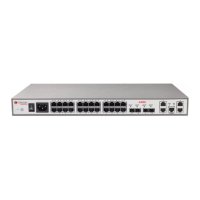A10E/A28E/A28F Configuration Guide
Figure 5-1 Mapping relation between IPv4 multicast address and multicast MAC address
Since the first 4 bits of IP multicast address are 1110, indicating multicast identification. In the
last 28bits, only 23 bits are mapped to the multicast MAC address. And the missing 5 bits
information will make 32 IP multicast addresses map to the same multicast MAC address.
Therefore, in Layer 2, the A10E/A28E may receive some other data out of IPv4 multicast
group, and these extra multicast data need to be filtered by the upper device.
Supported multicast features
The A10E/A28E supports the following multicast features:
Internet Group Management Protocol Snooping (IGMP) Snooping
Multicast VLAN Registration (MVR)
MVR Proxy
IGMP filtering
MVR Proxy is usually used with MVR.
IGMP filtering can be used with IGMP Snooping or MVR.
5.1.2 IGMP Snooping
IGMP Snooping (Internet Group Management Protocol Snooping) is multicast constraining
mechanism running on Layer-2 devices, used for multicast group management and control
and achieve Layer 2 multicast.
IGMP Snooping allows a Layer 2 device to monitor IGMP session between hosts and
multicast routers. When monitoring a group of IGMP Report from host, the Layer 2 device
will add host-connected interface to the forwarding entry of this group. Similarly, when
forwarding entry reaches aging time, the Layer 2 device deletes host-connected interface from
forwarding entry.
IGMP Snooping forwards multicast data by Layer 2 multicast forwarding entry. When
receiving multicast data, the Layer 2 device forwards them directly according to the
corresponding receiver interface of multicast forwarding entry, but not flood to all interfaces,
so as to save the switch bandwidth effectively.
IGMP Snooping establishes Layer 2 multicast forwarding entry, which can be learnt
dynamically or configured manually.

